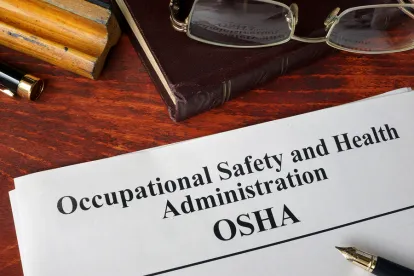As the country slowly begins the reopening process, OSHA has issued two new guidance documents—an Updated Interim Enforcement Response Plan for COVID-19 and Revised Enforcement Guidance for Recording Cases of COVID-19. Both documents go into effect on May 26, 2020, and both replace prior guidance documents adopted by OSHA on these topics.
Updated Interim Enforcement Guidance
Perhaps not surprisingly, as non-essential business have started to reopen, OSHA is fielding additional COVID-19 related complaints.
As more states are taking steps to reopen their economies and workers are returning to their workplaces, OSHA is receiving complaints from affected workers in non-essential businesses.
OSHA will continue to focus its efforts on COVID-19 related cases, and it will also continue to prioritize higher risk workplaces, such as hospitals and healthcare facilities. In this guidance, OSHA states that it will also focus enforcement attention on workplaces with high numbers of complaints or known cases of COVID-19. But its inspection policies will differ based on whether the employer is located in a geographic area with elevated community transmission or resurgence.
In high-risk workplaces, or in areas experiencing elevated COVID-19 cases, the updated guidance notes that fatalities and imminent danger exposures will be prioritized for inspection. Complaints alleging unprotected exposures to COVID-19 for workers in high risk workplaces will be prioritized for on-site or remote inspection. Similar complaints for lower risk workplaces, on the other hand, may only result in on-site inspection if the employer does not provide a satisfactory response to a remote investigation.
During an inspection, employers may be asked to provide OSHA with a written pandemic plan, which is recommended by the CDC, or other applicable written plans; procedures for hazard assessment; PPE protocols related to COVID-19; employee training records related to prevention of COVID-19; among other things.
This updated guidance will replace OSHA’s Interim Enforcement Response Plan adopted on April 13, 2020.
Revised Enforcement Guidance for Recording Cases of COVID-19
OSHA also updated its guidance for recordkeeping related to COVID-19. As we previously reported, employers must record cases of COVID-19 if:
- The case is a confirmed case of COVID-19, as defined by the Centers for Disease Control and Prevention (CDC);
- The case is work-related, as defined by 29 CFR 1904.5; and
- The case involves one or more of the general recording criteria set forth in 29 CFR 1904.7 (e.g., medical treatment beyond first-aid, days away from work).
In its updated guidance, OSHA provided more information on what it will consider in determining whether a case of COVID-19 is “work-related.” OSHA will consider the reasonableness of an employer’s investigation, evidence available to the employer, and evidence that COVID-19 was contracted at work.
The guidance gives examples of types of evidence that may weigh in favor of or against work-relatedness:
- COVID-19 illnesses are likely work-related when several cases develop among workers who work closely together and there is no alternative explanation.
- An employee’s COVID-19 illness is likely work-related if it is contracted shortly after lengthy, close exposure to a particular customer or coworker who has a confirmed case of COVID-19 and there is no alternative explanation.
- An employee’s COVID-19 illness is likely work-related if his job duties include having frequent, close exposure to the general public in a locality with ongoing community transmission and there is no alternative explanation.
- An employee’s COVID-19 illness is likely not work-related if she is the only worker to contract COVID-19 in her vicinity and her job duties do not include having frequent contact with the general public, regardless of the rate of community spread.
- An employee’s COVID-19 illness is likely not work-related if he, outside the workplace, closely and frequently associates with someone (e.g., a family member, significant other, or close friend) who (1) has COVID-19; (2) is not a coworker, and (3) exposes the employee during the period in which the individual is likely infectious.
This updated guidance will replace OSHA’s previous Enforcement Guidance for Recording Cases of COVID-19 adopted on April 10, 2020.
AFL-CIO Lawsuit
All of this guidance, however, is not enough for the AFL-CIO. Earlier this week, the AFL-CIO filed an emergency petition against OSHA demanding that OSHA enact an emergency temporary standard (ETS) within 30 days to address the COVID-19 pandemic. According to the AFL-CIO, OSHA has statutory authority to issue an ETS when employees are exposed to “grave danger” and an ETS is necessary to protect them from this danger.
We submit that in the face of a global health emergency causing more deaths in less time than any other workplace crisis OSHA has faced in its fifty-year existence, OSHA’s refusal to issue an ETS constitutes an abuse of agency discretion so blatant and of such magnitude as to amount to a clear abdication of statutory responsibility.
In re: American Federation of Labor and Congress of Industrial Organizations, D.C. Cir., No. 19-1158, May 18, 2020 (internal quotations omitted).



 />i
/>i

